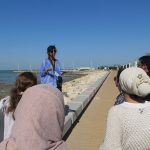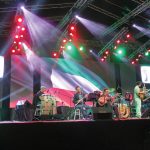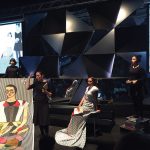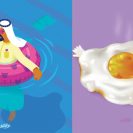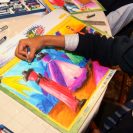By Muna M. Al Gharabally
Last month, Kuwait was buzzing as the 6th annual Nuqat Creative Conference was held from the 12th to 18th of November. This year, Nuqat, a non- profit organization dedicated to nurturing and encouraging creative development in the Arab world, lined up a week crammed full of lectures, cultural entertainment and workshops themed around the ‘Copy + Paste Syndrome’. There were so many overlapping events spread over multiple venues happening that speakers, participants, organizers and volunteers were all spoiled for choice.
The first three days of the conference were dominated by lectures held in the auditorium of the Al Amricani Cultural Centre. Registration for these lectures was free thanks to the generosity of The Ministry of State for Youth Affairs who covered the cost of each participant.
I have to confess, that when I first heard about the conference’s theme, I was concerned as copying and pasting an existing concept has always carried with it a bad reputation. Surely if you are copying and pasting something you are borrowing or outright stealing (when credit is not given to the source) someone else’s original idea? But as the Nuqat website challenges: ‘Is anything original?’ It is a very good question, as the seed of most ideas and concepts can be traced back to a ‘Eureka’ moment when observing something that already exists or has been tried before.
The theme led to many interesting debates by multiple speakers, often ending with lively Q&A sessions with the audience. From the presentations I saw, three speakers stood out as truly encapsulating the essence of the conference’s theme. They were: Leen Sadder, Ghadah AlKandari and Tareq Naga.
Leen Sadder is the product designer behind the idea of this is my toothbrush – hatha miswaki. Starting life as a class project, she took an old product that has been around for centuries and adopted it to modern day life so that it would appeal to all generations and all geographies. Her product reboot in stylish modern packaging has taken the humble miswak into the 21st Century and transformed it into an aspirational commodity that is both hip as well as healthy to use. What better way to demonstrate copy + paste and still be original?
Kuwaiti artist Ghadah Alkandari was the last speaker of Day One of the three days of lectures. Her lecture titled ‘Mirror: A Relationship Between Living and Creating’ painted a picture for the audience of how drawing has been a life companion for her. Ghadah has drawn and archived her drawings and writings her whole life. It has, as she says, preserved “the most accurate history” of who she is and has served her well as a sister, friend and therapist. She was able to transport the audience, who were lucky enough to be there, onto a different plane through just glimpses into her journals and body of work. An inspired artist and storyteller, copies of her paintings began to appear on the stage, pasting themselves onto the live canvas that was the podium from where she spoke. It needs to be said here that one of Ghadah’s creations are the “eves”, and at the end of her presentation, all of Ghadah’s “eves” streamed in to join her on the stage.
Tareq Naga is an architect who presented on the third and last day of the lectures. His lecture was built on an Albert Einstein quote ‘Great spirits have always encountered violent opposition from mediocre minds.”At the end of his presentation he went off schedule and showcased a story that was inspired by Ghadah Alkandari’s presentation on Day One and named it The Revenge of Adams. It has been said that imitation is the best form of flattery, Ghadah (with an “eve”, of course) was invited onto the stage at the end and Adam thanked Eve for her inspiration.
Whilst the auditorium hosted the lectures, the Al Amricani courtyard was a hub of activity, with live art installations by Mohammad Shono and a display of calligraffitti skills by Nugamshi. Also in the courtyard were food kiosks offering a mouth watering array of food that framed a central communal dining area where attendees could take a break to refuel and network, along with a pop up shop managed by ‘The Yard’ who were selling an eclectic array of products including Leen Sadder’s miswak.
The week was graced with beautiful weather and as night fell on the first day, the Al Amricani courtyard became the venue for live music overlapping recorded pop music hits that appeared to also be linked to a revolving installation on a small stage finished off with an accompaniment of roaring Harley Davidson motorbikes.
The vast array of cultural events on offer in this single week were just too many to list: there were book signings, art exhibitions, art installations, movies, musical events as well as city tours of Kuwait by Madeenah Tours (Instagram & Twitter: @madeenahkw) and a pop up restaurant that offered limited seats for a memorable brunch prepared by Kuwait’s own Two Chefs and a Waitress (#twochefsandawaitress) set up on this occasion at the Dar Al Funoon Art Gallery.
The last four days of the conference offered ten workshops, (all but one of these were held at the Dar Al Athar Al Islamiya’s Yarmouk Cultural Centre), by day and even more live music events and artistic presentations by night.
Al Shaheed Park was the venue for one such event called The Sound Social. In a performance, produced in collaboration with Al Shaheed Park and LOYAC, eight talented local musicians named The Trans Arabian Express premiered music that was created exclusively for the event. They opened with a Miles Davis influenced jazz number that had undertones of the oud and flute giving it an oriental flavor. Their music had hints of old Kuwaiti songs mixed with Yemeni reggae and African influences including Swahili folk music.
The audience was serenaded by their unique blend of fusion music in the open air theatre. Rising up behind the audience, the evolving Kuwait City skyline also listened. Liberation Tower and new brightly lit skyscrapers shimmered with their own unique light show. Dominating all the new buildings was Al Shaab Gate (one of the five remaining gates of Kuwait’s old walled city) which glowed as it held a place of honour from its central vantage point directly behind the audience.
The atmosphere that Nuqat 6 created in Kuwait was that of a grass roots art and music festival. Giving people the permission to look at what has been done already, drawing inspiration from it and creating their own version of the concept, theory or product.
The energy of the event revived the excitement, curiosity and exploration that was present in Kuwait in the 1950/60s giving the new generation of entrepreneurs a vibrant active and accommodating scene where they can capture the spirit and culture of the region not by copying and pasting ideas but by drawing inspiration from the past and molding something that is uniquely theirs all whilst giving them a platform to network and develop further.
For more information about Nuqat, visit www.nuqat.me, Leen Sadder (www.leensadder.com), Ghadah Alkandari (prettygreenbullet.com), and Dar Al Funoon Art Gallery (www.daralfunoon-kw.com).


